Letecia lives in Ojai, where the time now is:
Unique Readers:

Recent Search Engine Searches:
Primarily
Public Domain
Everything I've written here is hereby placed in the public domain. The quotes from other people's writings, and the
pictures used might or might not be copyrighted, but are considered fair use. Thus the license here would best be
described as:
Primarily Public Domain.
|
Syndication:

![Validate my RSS feed [Valid RSS]](http://www.worldtrans.org/pic/valid-rss.png)
WebLog Resources:
NCN NewsLogs
Weblogs.com
blo.gs
Technorati
Organica
DayPop
Blogdex
PopDex
Blogging Ecosystem
BlogTree
BlogStreet
BlogWise
BlogChalking
Wander-Lust
|
| Tuesday, December 20, 2005 |  |
|
|
|
 20 Dec 2005 @ 03:21 20 Dec 2005 @ 03:21
By Roland Pease
BBC News December 8, 2005
Scientists say they have witnessed the possible birth of a future ocean basin growing in north-eastern Ethiopia.
The team watched an 8m rift develop in the ground in just three weeks in the Afar desert region last September.
It is one small step in a long-term split that is tearing the east of the country from the rest of Africa and should eventually create a huge sea.
The UK-Ethiopian group says it was astonished at the speed with which the 60km-long fissure developed.
"It's the first large event we've seen like this in a rift zone since the advent of some of the space-based techniques we're now using, and which give us a resolution and a detail to see what's really going on and how the earth processes work; it's amazing," said Cindy Ebinger, from Royal Holloway University of London.
Professor Ebinger and colleagues described the event here at the American Geophysical Union Fall Meeting.
Earth forces
In the far-distant past, oceans such as the Atlantic have formed when supercontinents have torn apart.
Indeed, North America and Europe are still moving in opposite directions at about the pace fingernails grow.
Researchers have long recognised that the Afar region, an inhospitable depression in north-eastern Ethiopia, has been contorted by similar forces in recent geological time.
But the event in September is said to be unprecedented in scientific history.
It began with a large earthquake on the 14th of the month and continued with a swarm of moderate tremors.
Start and stop
"About a week into the sequence, there was a volcanic eruption," explained Dr Ebinger.
"A lot of ash was thrown up in the air, and a lot of cracks appeared in the ground; some of which were more than a metre wide.
"Using satellite techniques we can see ground deformation, and about a month after the sequence, we could see a 60km long section had opened up, and it opened up about 8m in its central part.
"It appears that we've seen the birth of an ocean basin."
Check here for the full story.
|
|
| Wednesday, November 19, 2003 |  |
|
|
|
 19 Nov 2003 @ 10:41 19 Nov 2003 @ 10:41
My father arrived in the United States as a 16 year old teen when there were signs up that said "no Filipinos or dogs allowed" posted in some public places. Hard to believe, huh?
1964 was not that long ago, which is when desegregation came into legislation. I was in the 4th grade. We had no blacks in our school and only a hand full of Mexican and Filipinos. In 1967 my best friend's father (white male and manager of the local J C Penny Store) told his daughter that "she should be hanging around people her own kind". In the early 1970's I was admitted to a Los Angeles, CA hospital for surgery as "other white" (go figure!).
Racism continues to hurt and confuse many, including me at times. I, along with many others work to create bridges of understanding where "difference" is not valued as "better" or "less than". Here is a good reference.
When I read the article below, I was reminded again about the work of Candace Pert and her book Molecules of Emotion. Candace says, "Your body is your subconscious mind" Here is an article on her Theory. Prejudices (racism) are not just in the brain, it lives in the body as well.
The HeartMath Inst teaches us that if we change our heart, our mind will follow!
By Shaoni Bhattacharya New Scientist November 17, 2003
People with implicit racial prejudices are left mentally exhausted after interacting with someone from a different race, perhaps because they are trying to quell their feelings.
The new study, the first of its kind, shows that areas in the brain associated with self-control light up in white people with implicit racial biases when they are shown images of black people.
Furthermore, the study showed that the level of this brain activity correlated very closely with poor performance in a test of thinking ability given right after a face-to-face interview with a black person. The researchers believe this indicates that the subject's mental resources have been temporarily drained by their efforts to suppress their prejudices.
Jennifer Richeson, who led the study, was surprised by the results. She believes it is now important to understand these neurological responses. "If we can understand the mechanism underlying this effect, we may be able to do something to intervene," Richeson, at Dartmouth College in New Hampshire, told New Scientist . More >
|
|
| Tuesday, November 18, 2003 |  |
|
|
|
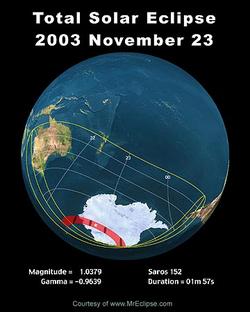 18 Nov 2003 @ 11:34 18 Nov 2003 @ 11:34
On Sunday, 2003 November 23, a total eclipse of the Sun will be visible from within a narrow corridor which traverses the far Southern Hemisphere. The path of the Moon's umbral shadow begins in the Indian Ocean, and quickly sweeps over portions of Antarctica. A partial eclipse will be seen within the much broader path of the Moon's penumbral shadow, which includes most of Australia and New Zealand, southernmost South America, and all of Antarctica.
For more details check here or here
In California the Total Solar Eclipse is at 2:50PM and the New Moon is Sagittarius is at 2:59pm
|
|
|
|
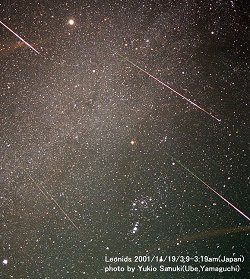 18 Nov 2003 @ 11:26 18 Nov 2003 @ 11:26
Space Weather News for Nov. 18, 2003
The 2003 Leonid meteor shower began on Nov. 13th with a mild flurry of meteors over the Pacific Ocean. It continues on Wednesday morning, Nov. 19th, with a much stronger peak over the Americas and western Europe.
Sky watchers on the Atlantic side of North America are favored; they could see as many as 80 meteors per hour between 1:30 a.m. and 4:00 a.m. local time. Western Europeans and South Americans ought to have a good view, too, shortly before local sunrise. (All these times refer to Wednesday morning, Nov. 19th.)
In western North America and around the Pacific Ocean the display will be weaker, perhaps 20 to 40 meteors per hour, but that's still a nice shower. Favored sites include Alaska and Hawaii before dawn on Nov. 19th and Japan after local midnight on Nov. 20th.
|
|
|
|
 18 Nov 2003 @ 11:10 18 Nov 2003 @ 11:10
By Dr David Whitehouse BBC News Monday, November 17, 2003
The giant sunspots that produced the largest explosion ever seen on the surface of our star are set to return.
They are moving back into view of the Earth after being carried to the Sun's far side by its 27-day rotation period.
Astronomers say that even out of direct vision the spots have continued to eject clouds of super-hot material.
The spots will point Earthwards again on 19 November. Although still very active, they are not expected to give out another X28-class solar fare.
Other side
Sunspot groups 486 and 488 produced record-breaking explosions earlier this month even though the Sun is supposed to be entering a period of declining activity - the peak of its 11-year cycle was a few years ago.
As the Sun's rotation took the groups out of view, astronomers were still able to keep an eye on them using a technique called helioseismic holography.
This allows the scientists to "look through" the Sun to see spot activity on the far side.
The holographic maps revealed 486 and 488 to still be active.
While on the far side of the Sun, explosions from their vicinity have been hurling clouds of gas over the Sun's limb in recent days.
Build up
The Sun's rotation will soon carry the pair back to the Earth-facing side of the star.
As they are still active, astronomers believe we are set for more solar storms when they reappear on or about Wednesday.
Indeed, the precursors to the giant sunspot group are just reappearing with the active region 484 just peeking over the Sun's eastern limb.
The spot looks smaller than it did in late October, but it too remains active - hurling a bright mass ejection into space on 13 November.
|
|
| Sunday, November 16, 2003 |  |
|
|
|
 16 Nov 2003 @ 00:22 16 Nov 2003 @ 00:22
By Helen Phillips New Scientist November 12, 2003
When you first fall in love, you are not experiencing an emotion, but a motivation or drive, new brain scanning studies have shown.
The early stages of a romantic relationship spark activity in dopamine-rich brain regions associated with motivation and reward. The more intense the relationship is, the greater the activity.
The regions associated with emotion, such as the insular cortex and parts of the anterior cingulate cortex, are not activated until the more mature phases of a relationship, says Helen Fisher, an anthropologist from Rutgers University in New Jersey.
Fisher and colleagues recruited seven male and 10 female volunteers who claimed to be madly in love. They asked them to look at pictures of either their loved one or another familiar person while inside a functional MRI scanner.
Eating chocolate
Early on in a relationship, the images showed that the brain seems to be very focused on planning and pursuit of pleasurable reward, says Fisher, mediated by regions called the right caudate nucleus and right ventral tegmentum. The same regions become active when a person enjoys the pleasure of eating chocolate, she adds.
There are also patterns that resemble aspects of obsessive compulsive disorder. "Activity in one particular area of the anterior cingulate cortex is in common," says Lucy Brown, a neuroscientist from Albert Einstein College of Medicine in New York, who was part of the research team. "The activity is correlated with the length of a relationship, lasting just into the emotional stage."
There are some differences between love-struck men and women, says Fisher. Women in love show more emotional activity earlier on in a relationship. They also seem to quiz their memory regions as they look at pictures of their partner, perhaps paying more attention to their past experience with them.
For men, perhaps unsurprisingly, love looks a little more like lust, with extra activity in visual areas that mediate sexual arousal.
The team has since moved on to examining the final phase of romance. "We are now looking at people who have just been rejected," says Fisher. The research was presented at the Society for Neuroscience's meeting in New Orleans on Tuesday.
|
|
| Saturday, November 15, 2003 |  |
|
|
|
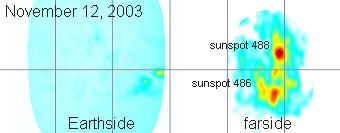 15 Nov 2003 @ 07:21 15 Nov 2003 @ 07:21
Space Weather News for Nov. 14, 2003
Using a technique called helioseismic holography, astronomers can do something amazing: look through the sun to find sunspots on the far side of our star. On Nov. 11th and 12th their holographic maps revealed giant sunspots 486 and 488--the same active regions that caused so much intense space weather a few weeks ago.
These spots are still active. Explosions from their vicinity have been hurling clouds of gas over the sun's limb in recent days. The sun's 27-day rotation will soon carry the pair around to the Earth-facing side of the sun. More solar storms are possible when they reappear on or about Nov. 19th.
Meanwhile, another one of last month's giant sunspots has already reappeared. Active region 484 is peeking over the sun's eastern limb. The sunspot looks smaller than it did in late October, but it too remains active--hurling a bright coronal mass ejection into space on Nov. 13th.
|
|
| Friday, November 14, 2003 |  |
|
|
|
14 Nov 2003 @ 08:02
Solar maximum is years past, yet the sun has been remarkably active lately. Is the sunspot cycle broken?
NASANovember 12, 2003: Imagine you're in California. It's July, the middle of summer. The sun rises early; bright rays warm the ground. It's a great day to be outside. Then, suddenly, it begins to snow--not just a little flurry, but a swirling blizzard that doesn't stop for two weeks.
That's what forecasters call unseasonal weather.
It sounds incredible, but "something like that just happened on the sun," says David Hathaway, a solar physicist at NASA's Marshall Space Flight Center.
Only a few weeks ago solar activity was low. The face of the sun was nearly blank--"very few sunspots," says Hathaway--and space weather near Earth was mild. "Mild is just what we expect at this point in the 11-year solar cycle," he explains. "The most recent maximum was in 2001, and solar activity has been declining ever since."
Then, suddenly, in late October the sun began to behave strangely. Three giant sunspots appeared, each one larger than the planet Jupiter. In California where smoke from wildfires dimmed the sun enough to look straight at it, casual sky watchers were startled by the huge blotches on the sun. One of them, named "sunspot 486," was the biggest in 13 years.
Sunspots cause solar flares and, usually, the biggest flares come from the biggest spots. The three giant sunspots unleashed eleven X-class flares in only fourteen days--equaling the total number observed during the previous twelve months. "This was a big surprise," says Hathaway.
The effects on Earth were many: Radio blackouts disrupted communications. Solar protons penetrated Earth's upper atmosphere, exposing astronauts and some air travelers to radiation doses equal to a medical chest X-ray. Auroras appeared all over the world--in Florida, Texas, Australia and many other places where they are seldom seen.
Researchers rank solar flares according to their x-ray power output. C-flares are the weakest. M-flares are middling-strong. X-flares are the most powerful. Each category has subdivisions: e.g., X1, X2, X3 and so on. A typical X-flare registers X1 or X2. On Nov. 4th, sunspot 486 unleashed an X28 flare--the most powerful ever recorded.
"In 1989 a flare about half that strong caused a widespread power blackout in Quebec," recalls Hathaway. Last week's blast was aimed away from Earth, so its effects on our planet were slight--a bit of good luck.
All this happened two years after solar maximum, which raises a question: is something wrong with the solar cycle? Is the sun going haywire?
"Nothing's wrong," reassures Hathaway. The sun isn't about to explode, nor is the sunspot cycle broken. "These latest sunspots were whoppers," he allows, "but sunspot counts averaged over many weeks are still declining as predicted. We're still on course for a solar minimum in 2006."
Indeed, it's possible that what we've just experienced is a normal part of the solar cycle, speculates Hathaway. "There's a curious tendency for the biggest flares to occur after solar maximum--on the downslope toward solar minimum. This has happened during two of the last three solar cycles."
Consider the year 1984, says Hathaway. Sunspot counts were plunging, and the sun was rapidly approaching the 1985-86 solar minimum. Suddenly a giant sunspot appeared, Jupiter-sized like sunspot 486, and unleashed two dozen M-flares and three X-flares, including a remarkable flare registering X13. People then probably wondered too if the solar cycle was broken.
"It's hard to be sure what's normal and what's not," notes Hathaway. "Astronomers have been observing x-rays from the sun for only 35 years--or three solar cycles. We can't draw good statistical conclusions from so few data."
One thing is certain, though: flurries of solar activity can happen at any time. The next time, says Hathaway, could be just a week or so away.
Sunspot 486 and its companions are on the far side of the sun now, carried around by the sun's 27-day rotation. "We suspect they're still active," says Hathaway, because the Solar and Heliospheric Observatory--a sun-watching satellite--has photographed clouds of gas being thrown over the sun's limb by unseen explosions. Unless these sunspots dissipate, which could happen, they will reappear on the Earth-facing side of the sun beginning as early as Nov. 14th.
And then...? No one knows. "We might get some more unseasonal space weather," says Hathaway. But this time he won't be surprised.
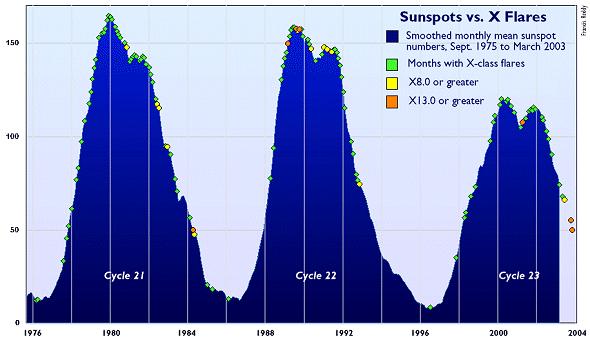
|
|
| Saturday, November 8, 2003 |  |
|
|
|
 8 Nov 2003 @ 16:14 8 Nov 2003 @ 16:14
By Celeste Biever
New Scientist November 5, 2003
Biologists have linked a mysterious, underwater farting sound to bubbles coming out of a herring's anus. No fish had been known to emit sound from its anus nor to be capable of producing such a high-pitched noise
"It sounds just like a high-pitched raspberry," says Ben Wilson of the University of British Columbia in Vancouver, Canada. Wilson and his colleagues cannot be sure why herring make this sound, but initial research suggests that it might explain the puzzle of how shoals keep together after dark.
"Surprising and interesting" is how aquatic acoustic specialist Dennis Higgs, of the University of Windsor in Ontario, describes the discovery. It is the first case of a fish potentially using high frequency for communication, he believes.
Arthur Popper, an aquatic bio-acoustic specialist at the University of Maryland, US, is also intrigued. "I'd not have thought of it, but fish do very strange and diverse things," he says.
Grunts and buzzes
Fish are known to call out to potential mates with low "grunts and buzzes", produced by wobbling a balloon of air called the swim bladder located in the abdomen. The swim bladder inflates and deflates to adjust the fish's buoyancy.
The biologists initially assumed that the swim bladder was also producing the high-pitched sound they had detected. But then they noticed that a stream of bubbles expelled from the fish's anus corresponded exactly with the timing of the noise. So a more likely cause was air escaping from the swim bladder through the anus.
It was at this point that the team named the noise Fast Repetitive Tick (FRT). But Wilson points that, unlike a human fart, the sounds are probably not caused by digestive gases because the number of sounds does not change when the fish are fed.
The researchers also tested whether the fish were farting from fear, perhaps to sound an alarm. But when they exposed fish to a shark scent, there was again no change in the number of FRTs.
Night waves
Finally, three observations persuaded the researchers that the FRT is most likely produced for communication. Firstly, when more herring are in a tank, the researchers record more FRTs per fish.
Secondly, the herring are only noisy after dark, indicating that the sounds might allow the fish to locate one another when they cannot be seen. Thirdly, the biologists know that herrings can hear sounds of this frequency, while most fish cannot. This would allow them to communicate by FRT without alerting predators to their presence.
Wilson emphasises that at present this idea is just a theory. But the discovery is still useful, he says. Herring might be tracked by their FRTs, in the same way that whales and dolphins are monitored by their high-pitched squeals. Fishermen might even exploit this to locate shoals.
There may even be a conservation issue. Some experts believe human-generated sounds can damage underwater mammals. Now it seems underwater noise might disrupt fish too.
Journal reference: Biology Letters
(DOI: 10.1098/rsbl.2003.0107)
|
|
| Thursday, November 6, 2003 |  |
|
|
|
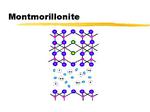 6 Nov 2003 @ 22:35 6 Nov 2003 @ 22:35
WASHINGTON http://www.cnn.com/2003/TECH/science/10/25/clay.life.reut/index.html --Science backed up religion this week in a study that suggests life may have indeed sprung from clay -- just as many faiths teach.
A team at the Howard Hughes Medical Institute and Massachusetts General Hospital in Boston said they had shown materials in clay were key to some of the initial processes in forming life.
Specifically, a clay mixture called montmorillonite not only helps form little bags of fat and liquid but helps cells use genetic material called RNA. That, in turn, is one of the key processes of life.
Jack Szostak, Martin Hanczyc and Shelly Fujikawa were building on earlier work that found clays could catalyze the chemical reactions needed to make RNA from building blocks called nucleotides.
They found the clay sped along the process by which fatty acids formed little bag-like structures called vesicles. The clay also carried RNA into those vesicles. A cell is, in essence, a complex bag of liquidy compounds.
"Thus, we have demonstrated that not only can clay and other mineral surfaces accelerate vesicle assembly, but assuming that the clay ends up inside at least some of the time, this provides a pathway by which RNA could get into vesicles," Szostak said in a statement Thursday.
"The formation, growth and division of the earliest cells may have occurred in response to similar interactions with mineral particles and inputs of material and energy," the researchers wrote in their report, published in the journal Science.
"We are not claiming that this is how life started," Szostak stressed.
"We are saying that we have demonstrated growth and division without any biochemical machinery. Ultimately, if we can demonstrate more natural ways this might have happened, it may begin to give us clues about how life could have actually gotten started on the primitive Earth."
Among religious texts that refer to life being formed from the soil is the Bible's Book of Genesis where God tells Adam, (King James translation), "In the sweat of thy face shalt thou eat bread, till thou return unto the ground; for out of it wast thou taken: for dust thou art, and unto dust shalt thou return."
Copyright 2003 Reuters. All rights reserved. This material may not be published, broadcast, rewritten, or redistributed.
|
|
Page: 1 2 Older entries >> |
|

